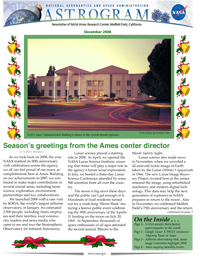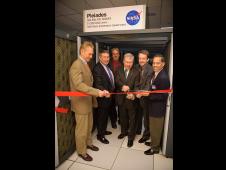Connect to NASA Ames
Ames in the News
Earth-hunter telescope prepared for launch (uk.reuters.com)→
Foothill-De Anza ready to sign on to NASA Research Park (www.mv-voice.com)→
CU aerospace program begins 2009 on a roll (www.examiner.com)→
NASA-Derived Technology Captures Unique Inaugural Image (www.marsdaily.com)→
Read about NASA Ames in other news stories
Ames Astrogram
The NASA Ames Employee Newsletter

› View the December issue of the Astrogram
› View Archive
Featured Stories
News and Features
-

NASA Kepler Launch International Media Accreditation Ends Feb. 5
01.27.09 - The launch of NASA's Kepler telescope, the first mission capable of finding Earth-size planets around other stars, is scheduled for March 5 at 7:48 p.m. Pacific Time (10:48 p.m. Eastern time), from Cape Canaveral Air Force Station, Fla.
-

NASA Tracks Changes to Earth's Green-covered Regions
01.22.09 - NASA's satellite imagery, combined with high-resolution commercial imagery, is giving scientists new insight into the changing appearance of our planet on a regional scale, and whether it is due to human activity or extreme climate.
-
NASA Ames Celebrates Mars Twin Rovers' Many Accomplishments
01.21.09 - The Mars Exploration Rovers (MER), Spirit and Opportunity, continue to provide NASA with valuable insight about the planet Mars. Although the rovers had a life expectancy of 90 days, they have continued science operations on the Red Planet for five years.
-

Astronauts Call Lakebay Washington Students From Space Station
01.15.09 - Reporters are invited to witness students from Key Peninsula Middle School of Lakebay, Wash., while they chat with NASA Expedition 18 astronauts Mike Fincke and Sandra Magnus, who are aboard the International Space Station on Jan 21, 2009.
Ames on the Web
Center Director
-

NASA Ames Center Director
S. Pete Worden
Ames Image of the Week
Visiting Ames
-

NASA Exploration Center
Visitors are welcome to view exhibits from NASA Ames Research Center.
Let's Save Hangar One
Ames Academy
-

NASA Ames Academy →
NASA Ames Academy for Space Exploration Now Accepting Applications (Deadline 1/26/09)







